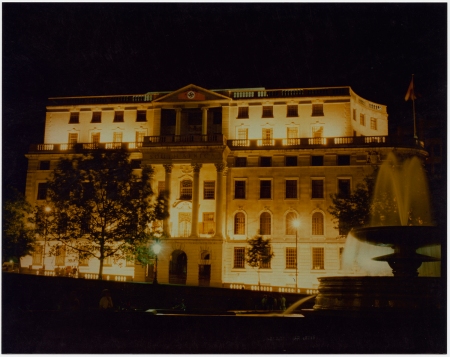Four year legal battle ends with substantial donations to civil + human rights groups

In Strange Culture, filmmaker Lynn Hershman-Leeson tackles the bizarre case of Steve Kurtz, an associate professor of art at SUNY/Buffalo and founding member of the award-winning art and theater collective Critical Art Ensemble, whose interactive projects include the examination of biotechnology and the issues surrounding it. Kurtz’s life suffered an upheaval of Kafkaesque proportions following the unexpected death of his wife, Hope, of heart failure in May 2004.
via Alternative Film Guide
CAE Defense Fund donated to Center for Constitutional Rights & New York Civil Liberties Union
Buffalo, NY—After a widely watched four-year legal battle, the CAE Defense Fund was officially dissolved last week, with its remainder of unexpended funds donated in two substantial gifts to the Center for Constitutional Rights (CCR) and the New York affiliate of the American Civil Liberties Union (NYCLU).
The CAE Defense Fund was originally created as a mechanism to raise funds for legal bills incurred by Dr. Steven Kurtz and Dr. Robert Ferrell in what its members argued was a politically motivated attack by the Department of Justice—one which threatened the constitutional and fundamental rights not only of the two defendants, but also of everyone, due to legal precedents that would have been set by an unfavorable outcome.
In response, thousands of people worldwide organized demonstrations and raised money for the two men’s legal defense through fundraisers and a variety of other grassroots efforts.
The fund was also heavily supported by internationally renowned artists including Sol Lewitt, Richard Serra, Hans Haacke, Cindy Sherman, Carl Andre, Mike Kelley, Kiki Smith, Sam Durant, Mark Dion, Jeremy Deller, and many others, who donated work to an auction at Paula Cooper Gallery in April 2005. Other artists such as Chuck Close, Walid Raad, and Ed Ruscha made substantial direct cash contributions. In all, the Fund raised approximately $350,000.
Drs. Kurtz and Ferrell were indicted for mail and wire fraud in June of 2004. Under the USA PATRIOT Act, the maximum sentence for those charges was increased from five years to twenty years in jail. After an arduous four-year-long struggle, in April of 2008 the indictment against Kurtz was finally dismissed by Federal Judge Richard J. Arcara as “insufficient on its faceâ€â€”meaning that even if the actions alleged in the indictment (which the judge must accept as “factâ€) were true, they would not constitute a crime. Ferrell pleaded guilty to a misdemeanor charge in October 2007 after recurring bouts of cancer and three strokes suffered during the course of the case prevented him from continuing the struggle.
When the case was dismissed instead of going to trial, approximately $108,930 remained in the fund.
“Had the case gone to a jury trial, that amount wouldn’t have been enough to cover Steve’s legal bills through the trial, let alone appeals in the event of a guilty verdict†explained Edmund Cardoni, Executive Director of Hallwalls Contemporary Arts Center in Buffalo NY, and the Fund’s fiscal administrator. “When the case was finally thrown out, we were thrilled, but we were presented with a new problem. The committee was very conscious of our ethical responsibility to make sure this money would be used in a way that honored the original intent of the many people who gave money to the fund, and the artists who donated art works to the fundraising auction.â€
In keeping with that purpose—to defend our fundamental constitutional rights—the CAE Defense Fund and Trial Fund committees, in consultation with artists, curators, and others centrally involved in the fundraising efforts, voted to disburse the remaining funds by awarding 80 percent ($87,150) to the CCR, and 20 percent ($21,780) to the NYCLU.
CAE Defense Fund coordinator Lucia Sommer said, “We are extremely happy that the case is over, and that the remaining funds can be passed on to organizations that have such a distinguished record of defending not only the U.S. Constitution, but also the human rights and dignity of all people.â€
Added Kurtz, “I always promised everyone who donated their time, labor and hard-earned money to our defense that this struggle would do more than demonstrate to the Justice Department that the art, science, academic and activist communities would not be intimidated by its authoritarian tactics. We knew the legal precedent set by the case was critical to preventing what happened to Bob and me from happening to others, and it’s incredibly rewarding to know that these funds can now be used to defend others who do not have the kind of support we had.â€
Representatives of both organizations expressed gratitude for the donations.
“The NYCLU is very pleased to receive this generous contribution from the CAE Legal Defense Fund to continue our work in restoring, defending, and upholding our constitutional and fundamental rights, including artistic and academic freedoms,†said Donna Lieberman, Executive Director of the New York Civil Liberties Union.
Vincent Warren, Executive Director of the Center for Constitutional Rights, congratulated the CAE Defense Fund “and its many dedicated and principled supporters for your extraordinary victory—a victory for our country and the Constitution as much as it is for the individuals.†He further stated that, “The CCR is honored to use the tremendous support of the Fund’s donors to continue the fight against repression of dissent and illegal detentions—work which, unfortunately, is still sorely needed.â€
For more information about the case, please visit: http://caedefensefund.org




